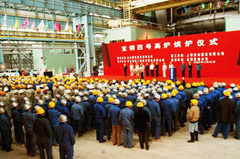What happens when the world’s most populous nation goes from saving most of its money to spending it? Many consumer products companies are itching to know just that — and want to be there when it happens. While most people think of China as a global manufacturer of products for the rest of the world, it is also fast becoming (and in some cases, already is) the biggest consumer of goods. What its people choose to buy will play a huge role in the kinds of goods that are produced, how they are marketed, and even where they are sold. In a panel at this year’s Wharton China Business Forum, experts talked about how best to tap into the vast pool of potential buyers in China — and the purchasing power of its rising middle class.
Want vs. Need
The expenditure of money on discretionary items is a relatively recent phenomenon in China. Jay McIntosh, Americas director of retail and consumer products at Ernst & Young, noted that the Chinese population saves a great deal more than its counterparts in the U.S. “As the country moves from agricultural to industrial, more people will be in urban areas — meaning they will be less self-sufficient and more likely to pay for things,” he said. “Historically, essential purchases like food have been the primary economic drivers, but recently nonfood sales have been gradually overtaking those. The middle class is expected to rise to 45% by the year 2020, assuming a 15% compound annual growth rate.” Automobile ownership is also on the rise in China, said McIntosh: “The implications for retailers are vast. Cars can have a major impact on how people shop.”
McIntosh pointed out that many in the middle and upper classes are growing up with so-called “Little Emperor Syndrome:” Due to the country’s one-child policy, a child may be supported by parents as well as two sets of grandparents – and thus will likely demand more consumer products as an adult.
The Chinese policy of allowing married people who were only children to have two kids of their own will also affect consumer buying patterns as the middle class expands, added Milton Kotler, president of Kotler Marketing Group. “Consumer credit hasn’t yet penetrated even the rich. Credit cards are used primarily for business purposes. All else is bought with cash. Once credit cards hit the middle class, that will greatly expand retail spending. China will, in this decade, become a consumer society.”
Market Savvy
According to Kotler, the profile of the middle class varies significantly across Chinese cities, yet the overall trend is toward urbanization. “Forty percent of the population is now urbanized, which is up from 20% one decade ago,” he said. “There has been rapid development, especially in the western part of China.” Still, the upper class is the main focus of foreign marketing investment. “The middle class buys generic goods. They don’t do much in the way of discretionary purchasing, and they are very price conscious. They tend to buy domestic brands.” Numerous big chain stores are cropping up, he noted, from Wal-Mart to Carrefour.
In terms of product quality, there is a lot of copying and little innovation in China because of lack of capital, said Kotler. “Very few Chinese brands have brand equity. Manufacturers want to differentiate, but they can’t afford to. So they copy something instead.”
How goods are displayed also could stand improvement, Kotler noted, and foreign companies can take advantage of the situation. “Merchandising is poor. Stores are more like bazaars than merchant enterprises. There is little real domestic store branding, and no control of design, atmosphere, and so forth. Customer service is treated as a company cost instead of a center of added value. But well-capitalized foreign enterprise will drive service standards higher.”
International Branding
Susan Baida, Asia-Pacific regional marketing director for Clinique, said that China is second only to Japan in the Asian cosmetics market. She noted that high-end cosmetics demand is rising as well. “The prestige market is 8% ($500 million) of the total cosmetics market in China, and it’s growing.”
Clinique, explained Baida, entered China in the 1990s through its Hong Kong affiliate. “Not until we globalized the corporation and the brands did we establish an office in China, and that was in 2000. We are the second-fastest growing brand in the top 10, and we are doing very well,” Baida noted. “Our top line strategy was to establish a brand management team first — including a brand manager, marketing manager, and sales manager, as well as education and supplemental staff. Then we forged relationships with key retailers.
“We conducted extensive market research and consumer research to find out how we were perceived and how our products were perceived,” added Baida. “We took steps to improve the service received at retail counters, and our brand image. We hired our own consultants who were well trained to communicate the brand.” In 2003, said Baida, they relaunched the brand with a distinct focus on skin care, since that was seen as more important in Asia than simply makeup per se. “We introduced a new ad campaign as well as a [program for] customer recruitment and retention.”
Foreign brands such as Clinique, added Bernd Schmitt, professor of international business at Columbia Business School, face the challenge of expanding beyond the cities in China — going beyond being known only as the “premium brands” and still keeping their advantage. For domestic Chinese brands, the challenge is just the opposite: “The Chinese think their brands aren’t of such good quality, so their challenge is to go more upscale,” he said. “They need more marketing and advertising.”



